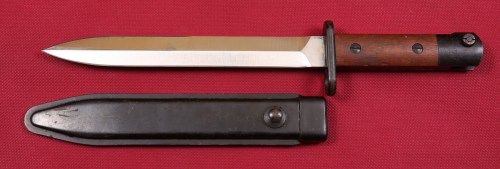Denmark
The development of the Danish bayonet can be traced back to the early 17th century. In 1611, the Danish king Christian IV ordered the production of 10,000 muskets and bayonets. These early bayonets were simple plug bayonets, which were inserted into the muzzle of the musket when not in use.
In 1794, the Danish army adopted a new socket bayonet, known as the M/1794. This bayonet was designed to fit over the barrel of the musket, and it had a locking mechanism to keep it in place. The M/1794 bayonet was a significant improvement over previous designs, and it remained in service with the Danish army for over a century.
In the late 19th century, the Danish army began to experiment with new bayonet designs. In 1896, the Danish army adopted the M/1896 bayonet, which was designed to fit the new Krag-Jørgensen rifle. The M/1896 bayonet was a ring bayonet, which meant that it had a ring that fitted around the barrel of the rifle. This made the bayonet more secure and easier to use.
In 1947, the Danish army adopted the M/1947 bayonet, which was designed to fit the new Madsen-Ljungman rifle. The M/1947 bayonet was a combination bayonet, which meant that it could be used as a fighting knife as well as a bayonet. The M/1947 bayonet remained in service with the Danish army until the late 20th century.
In the modern era, the Danish army has adopted a number of different bayonet designs, depending on the specific rifle or carbine being used. However, the basic principles of bayonet design have remained the same for over 400 years.
Here is a more detailed account of the development of the Danish bayonet in the context of the major technological and military changes that were taking place at the time:
**Early 17th century:** Plug bayonets are introduced, inserted into the muzzle of the musket when not in use.
**Late 17th century:** Socket bayonets are introduced, which fit over the barrel of the musket and have a locking mechanism to keep them in place.
**Early 18th century:** Ring bayonets are introduced, which have a ring that fits around the barrel of the rifle, making the bayonet more secure and easier to use.
**Mid-19th century:** With the introduction of rifled muskets, which have a smaller bore diameter than smoothbore muskets, bayonets are also made with smaller blades to fit the new weapons.
**Late 19th century:** Combination bayonets are introduced, which can be used as fighting knives as well as bayonets.
**Early 20th century:** With the development of semi-automatic and automatic rifles, bayonets become less important in combat. However, they are still retained by some militaries for use in close-quarters combat.
**Modern era:** Bayonets are still used by some militaries today, but they are primarily used as a last resort weapon. In recent years, there has been a renewed interest in bayonets, as some militaries have recognized their potential usefulness in urban combat and counter-insurgency operations.
The Danish bayonet has evolved over the centuries to meet the changing needs of the Danish army. It has been used in many different conflicts, from the Thirty Years’ War to the present day. The Danish bayonet is a symbol of Danish military prowess and tradition.
Showing all 11 results










